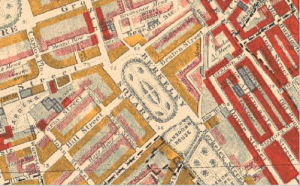Berkeley Square is located in the north of Piccadilly and was named after the first Lord of Berkeley of Stratton, John Berkeley. In 1696, the third Lord of Berkeley sold the Berkeley House and its property to the Duke of Devonshire under the circumstances that the grounds, spanning the width of the house and the length of the garden, could not be built on, with the purpose of preserving the view from the front of the house. This preserved space became the square (Berkeley Square, North Side).
In 1733, when the Berkeley House was demolished, the square was divided in half. The southern half of the square became the Grosvenor estate (what is now the Landsdowne House), and the northern half became what is now the present day public space (Berkeley Square). Two carpenters that invested in the creation of the Grosvenor estate, Edward Cook and Francis Hillard, developed the area around the square from the mid-to-late 1700s: creating new roadways, buildings, and commercial spaces. By 1790, the surrounding occupants of Berkeley Square included a hosier, a fruiterer, a shoemaker, a watchmaker, and a bookseller (Berkeley Square, North Side).
However, these buildings—which were all residences with shops on the bottom floor—were considered unacceptable by West-End standards. By 1817, new building plans were created to turn Berkeley Square into a more high-end area. The estate surveyor, who decided the value of the property, estimated the area immediately surrounding the square to be worth “ten guineas per foot frontage”—an extraordinarily high price. Because of this, there were no immediate offers. However, plans to create a high-end neighborhood still pursued: roadways were rearranged and the existing houses were demolished (Berkeley Square, North Side).
By 1820, the grounds were being advertised in newspapers. But, it wasn’t until 1821 when the area received its first accepted offer (the original surveyor, who was strict on his price, had to die before this could happen). John Bailey, the owner of a hotel already located on the square, bought another property on the west corner for 5 guineas per foot. After the sale, the reduced price became the standard for all properties surrounding the square to be sold; by October 1821, they were all taken up (Berkeley Square, North Side).
As seen by the Charles Booth Poverty Map, the area surrounding Berkeley Square was occupied by the wealthy upper class. Berkeley Square was home not only to the Lord of Berkeley and the Duke of Devonshire, but also other wealthy elite and notable persons such as William Fullarton, the Sixth Earl of Stair, Edward Bouverie, Sir William Wolseley, and General Sir Banastre Tartleton (Berkeley Square, North Side).
Berkeley Square & Dorian Gray
Berkeley Square was mentioned once within the first five chapters of Dorian Gray: “Lord Henry passed up the low arcade into Burlington Street and turned his steps in the direction of Berkeley Square. […] Suddenly he stopped and glanced up at the houses. He found that he had passed his aunt’s some distance, and, smiling to himself, turned back.” Lord Henry’s Aunt Agatha is suggested to live near Berkeley Square. As Berkeley Square is a very rich neighborhood, it suggests that Aunt Agatha is a very wealthy upperclass woman with elite status. Unlike Lord Henry, who makes it clear that he does not sympathize with the poor, Aunt Agatha does charity work in the East End. The humor of her charity work, as mentioned in my post about Whitechapel, is that she doesn’t supply the poor with things they need—money, food, shelter—but instead, entertains them. Her recognition of the poor, as someone of high social status, sets her apart from other wealthy elite, who often disregarded and show no mercy toward the poor. However, her lack of understanding for their actual needs displays how disconnected the wealthy upperclass were from the realities of those living in poverty, as if putting on an entertaining show would help cure them of their plight. Even the most sympathetic of the wealthy elite couldn’t possibly understand what it was like to live in poverty.
Furthermore, Aunt Agatha’s desire to satisfy the needs of impoverished people with music (an art form) suggests how ridiculous it is to believe that a life can solely be lived off of absorbing art. It minimizes the importance of art in the presence of other human needs. It is also, perhaps, foreshadows Dorian’s demise after trying to live a life fueled by art and beauty. What is art when you don’t have the basic essentials to live a healthy life. Dorian’s unhealthy lifestyle—his lacking human compassion and kindness—ends in his hideous death.
Works Cited
“Berkeley Square.” Hidden London. Hidden London, n.d. Web. 24 Nov. 2015.
‘Berkeley Square, North Side.’ Survey of London: Volume 40, the Grosvenor Estate in Mayfair, Part 2 (The Buildings). Ed. F H W Sheppard. London: London County Council, 1980. 64-67. British History Online. Web. 25 November 2015.
“Booth Poverty Map & Modern Map (Charles Booth Online Archive).” Charles Booth Online Archive. London School of Economics & Political Science, n.d. Web. 23 Nov. 2015.


